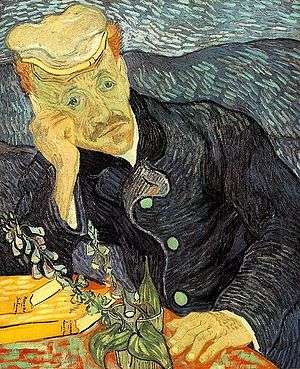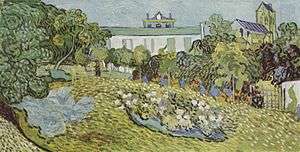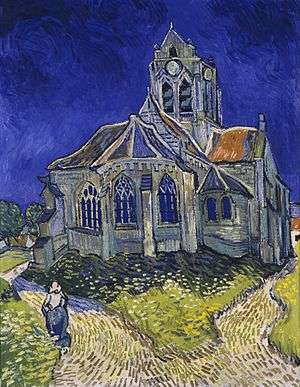Auvers-sur-Oise
| Auvers-sur-Oise | ||
|---|---|---|
|
The Château de Leyrit, built in the 17th and 18th centuries | ||
| ||
 Auvers-sur-Oise | ||
|
Location within Île-de-France region  Auvers-sur-Oise | ||
| Coordinates: 49°04′21″N 2°10′30″E / 49.0725°N 2.1750°ECoordinates: 49°04′21″N 2°10′30″E / 49.0725°N 2.1750°E | ||
| Country | France | |
| Region | Île-de-France | |
| Department | Val-d'Oise | |
| Arrondissement | Pontoise | |
| Canton | Saint-Ouen-l'Aumône | |
| Intercommunality | Vallée de l’Oise et des Impressionnistes | |
| Government | ||
| • Mayor (2014–2020) | Isabelle Mézières | |
| Area1 | 12.69 km2 (4.90 sq mi) | |
| Population (2013)2 | 6,894 | |
| • Density | 540/km2 (1,400/sq mi) | |
| Time zone | CET (UTC+1) | |
| • Summer (DST) | CEST (UTC+2) | |
| INSEE/Postal code | 95039 / 95430 | |
| Elevation | 21–111 m (69–364 ft) | |
|
1 French Land Register data, which excludes lakes, ponds, glaciers > 1 km² (0.386 sq mi or 247 acres) and river estuaries. 2 Population without double counting: residents of multiple communes (e.g., students and military personnel) only counted once. | ||
Auvers-sur-Oise (French pronunciation: [o.vɛʁ.syʁ.waz]) is a commune in the northwestern suburbs of Paris, France. It is located 27.2 km (16.9 mi) from the centre of Paris. It is associated with several famous artists, the most prominent being Vincent van Gogh.
History
During the 19th century, a number of painters lived and worked in Auvers-sur-Oise, including Paul Cézanne, Charles-François Daubigny, Camille Pissarro, Jean-Baptiste-Camille Corot and Vincent van Gogh. Daubigny's house is now a museum where one can see paintings by the artist, his family, and friends, such as Honoré Daumier, as well as rooms decorated in period style.
If you walk along the river from Auvers toward Pontoise you can see a number of views which figured in the paintings of Pissarro.
During the 20th century artists continued to frequent Auvers, including Henri Rousseau (Douanier Rousseau), Otto Freundlich and Pierre Daboval. The COBRA artist Corneille spent his last years in the village and is buried a few meters from Vincent van Gogh.[1]
On 1 August 1948, 17% of the territory of Auvers-sur-Oise was detached and became the commune of Butry-sur-Oise.
Population
| Year | 1793 | 1800 | 1806 | 1821 | 1831 | 1836 | 1841 | 1846 | 1851 | 1856 |
|---|---|---|---|---|---|---|---|---|---|---|
| Population | 1754 | 1635 | 1708 | 1705 | 1806 | 1522 | 1530 | 1547 | 1553 | 1574 |
| Year | 1861 | 1866 | 1872 | 1876 | 1881 | 1886 | 1891 | 1896 | 1901 | 1906 |
|---|---|---|---|---|---|---|---|---|---|---|
| Population | 1648 | 1635 | 1720 | 1638 | 1713 | 1936 | 2063 | 2255 | 2402 | 2544 |
| Year | 1911 | 1921 | 1926 | 1931 | 1936 | 1946 | 1954 | 1962 | 1968 | 1975 |
|---|---|---|---|---|---|---|---|---|---|---|
| Population | 2681 | 2961 | 3132 | 3240 | 3163 | 3345 | 3172 | 3772 | 5124 | 5808 |
| Year | 1982 | 1990 | 1999 | 2008 |
|---|---|---|---|---|
| Population | 5722 | 6129 | 6820 | 6879 |
Van Gogh
Dr. Paul Gachet lived in Auvers-sur-Oise. He was acquainted with the avant-garde artists of the time. Through this connection, Vincent van Gogh moved to Auvers to be treated by him, though he considered the doctor to be in a worse state than himself. Gachet befriended Van Gogh and was the subject of two portraits, one of which, Portrait of Dr. Gachet, was sold at auction for over $80m (£48m) in 1990.[2]
Van Gogh died by a gunshot to the chest. The room on the upper floor of the Auberge Ravoux where he died has been preserved, although no furniture remains. Auvers-sur-Oise is the final resting place of both Vincent and his brother Theo van Gogh, who died six months later.[2]
-

L’Auberge Ravoux, where Vincent van Gogh spent his final months and where he died. It is now a restaurant.
-

View from the staircase leading up to Van Gogh's room in L'Auberge Ravoux
-

Vincent and Theo van Gogh's graves in Auvers-sur-Oise.
- Auvers-sur-Oise in art
-

Portrait of Dr. Gachet by Vincent van Gogh
-
_-_Wheat_Field_with_Crows_(1890).jpg)
Wheat Field with Crows, one of Van Gogh's last paintings
-

Daubigny's Garden, possibly Van Gogh's final painting
-

Camille Pissarro,
A Cowherd at Valhermeil, Auvers-sur-Oise, The Metropolitan Museum of Art -

Charles Joseph Beauverie, Auvers-sur-Oise (Bâteau lavoir à Auvers), ca.1870
-

Frédéric Samuel Cordey, Ruelle à Auvers sur Oise, circa 1903
Transport
Auvers-sur-Oise is served by two stations on the Transilien Paris – Nord suburban rail line: Chaponval and Auvers-sur-Oise.
See also
References
- ↑ "IVincent van Gogh's Grave". Minor Sights. 14 November 2014. Retrieved 2015-02-28.
- 1 2 Dowd, Vincent (24 October 2009). "In the footsteps of Vincent van Gogh". BBC News. Retrieved 2009-10-25.
External links
| Wikimedia Commons has media related to Auvers-sur-Oise. |
%2C_ch%C3%A2teau_de_Leyrit%2C_rue_de_L%C3%A9ry.jpg)
.svg.png)
